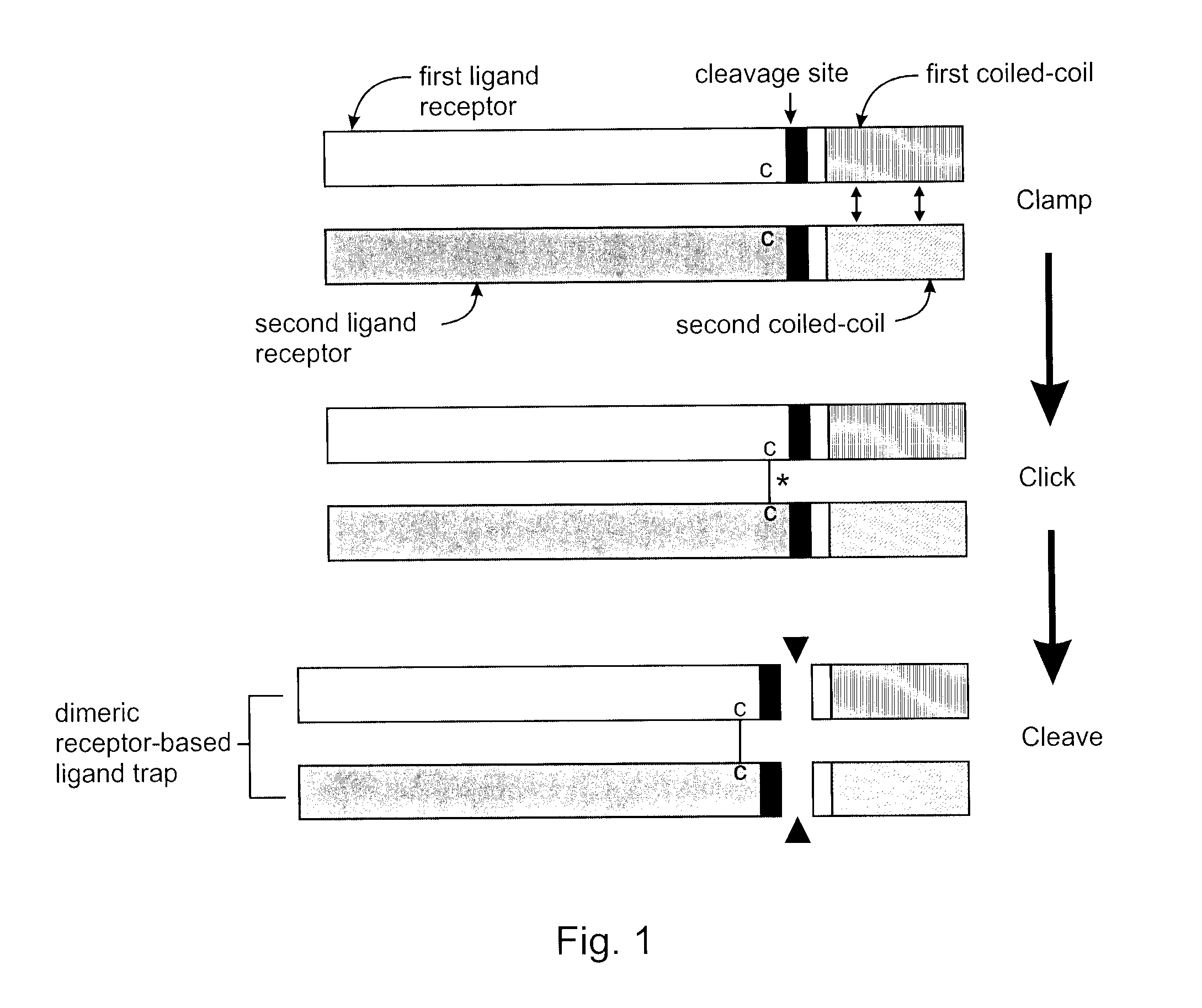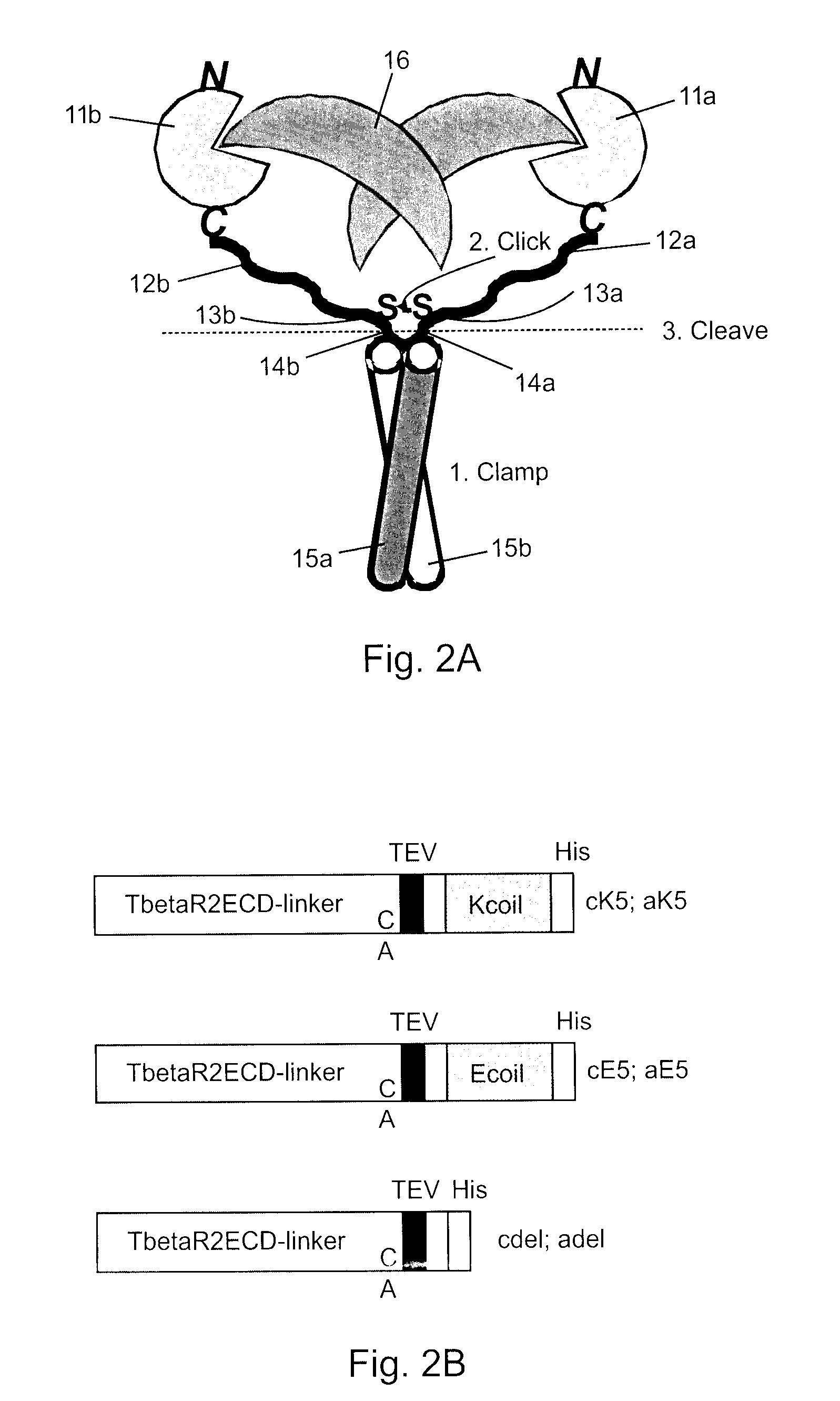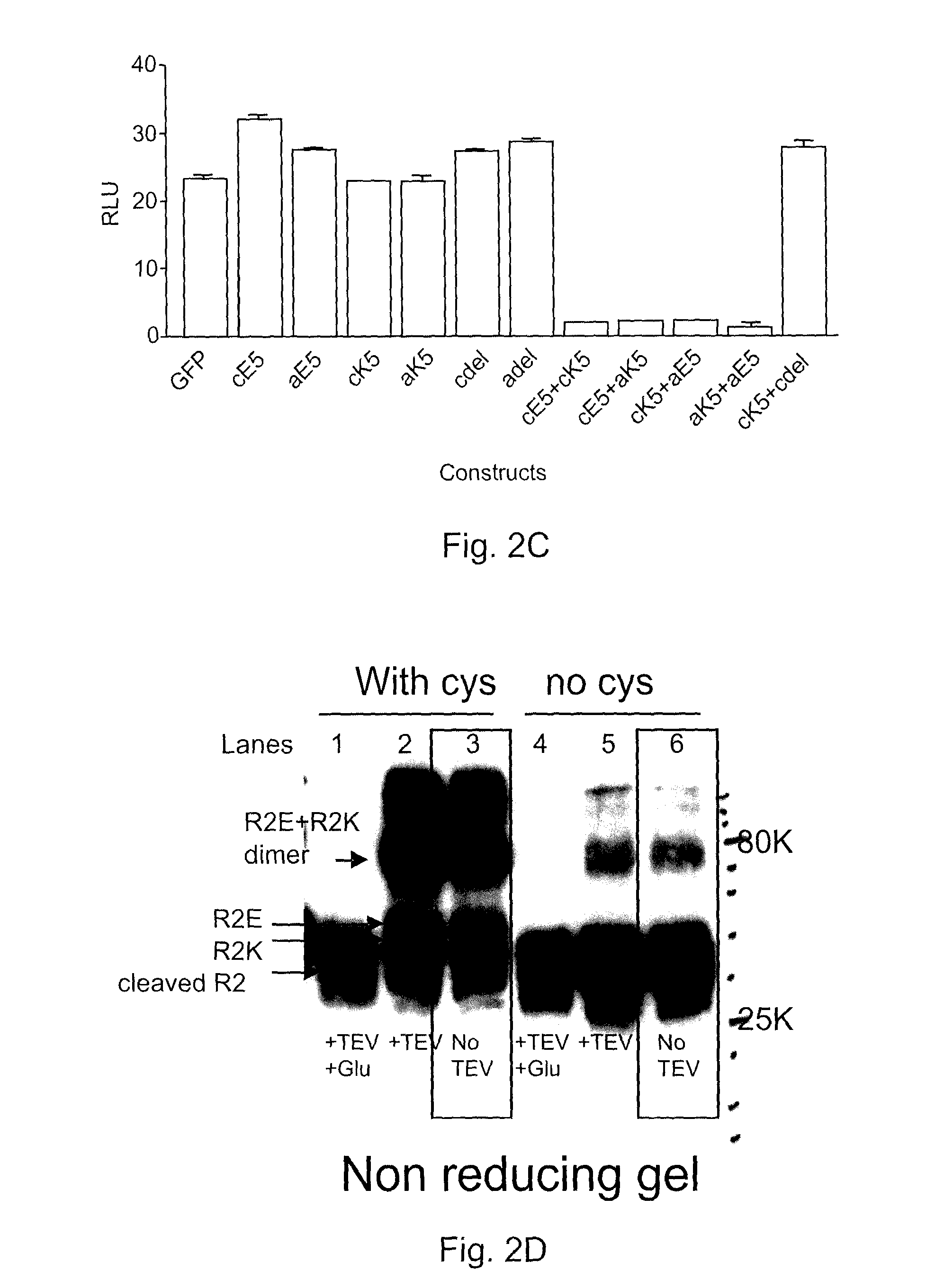Covalently dimerized bivalent binding agents
a bivalent, binding agent technology, applied in the field of binding agents, can solve the problems of reducing the potency of the trap, fibrotic disorders, severe disease pathologies,
- Summary
- Abstract
- Description
- Claims
- Application Information
AI Technical Summary
Benefits of technology
Problems solved by technology
Method used
Image
Examples
example 1
Homodimeric TGF-β RII-Coil Trap Dimers
[0056]With reference to FIG. 2A and FIG. 2B, in this example fusion peptides are constructed as described above comprising TGF-β RII ectodomains (TβR2ECD) 11a,b with N-terminal signal sequences, short first linker sequences 12a,b, cysteine residues 13a,b, short second linker sequences (not labeled), TEV cleavage sites 14a,b, short third linker sequences (not labeled), either E5 coil sequence 15a or K5 coil sequence 15b, short fourth linker sequences (not labeled), and 6×His tags at the C-terminal ends. When these peptides are mixed together the E and K coils promote non-covalent dimerization (step 1, clamp) and the formation of an interchain disulfide bond (step 2, click) to form a trap dimer of the present invention. The coils are subsequently excised by TEV protease cleavage (step 3), producing a covalently linked, homobivalent TGF-β trap of the present invention that is free of the artificial coils. Using this method the TGF-β RII receptors a...
example 2
TGF-β RI-Coil and TGF-β RII-Coil Fusion Constructs with Cysteine on the C-Terminal Side of the Protease Cleavage Site
[0064]To validate the ability to form disulphide bonds between two cysteine residues in a TGF-β-coil trap dimer and to illustrate improved potency of the covalently bound dimer over non-covalently bound coiled-coil dimerized traps, TβR1-coil and TβR2-coil fusion constructs with and without C-terminal cysteine residues were constructed. The constructs are as follows:
TβR2ECD-E5 cys(R2Ec-SEQ ID NO: 19)[MGRGLLRGLWPLHIVLWTRIAST]IPPEQKLISEEDLLHVQKSVNNDMIVTDNNGAVKFPQLCKFCDVRFSTCDNQKSCMSNCSITSICEKPQEVCVAVVVRKNDENITLETVCHDPKLPYHDFILEDAASPKCIMKEKKKPGETFFMCSCSSDECNDNIIFSEEYNTSNPDggrggggsggg[EVSALEKEVSALEKEVSALEKEVSALEKEVSALEK]gggCTβR2ECD-E5(R2E-SEQ ID NO: 20)[MGRGLLRGLWPLHIVLWTRIAST]IPPEQKLISEEDLLHVQKSVNNDMIVTDNNGAVKFPQLCKFCDVRFSTCDNQKSCMSNCSITSICEKPQEVCVAVVVRKNDENITLETVCHDPKLPYHDFILEDAASPKCIMKEKKKPGETFFMCSCSSDECNDNIIFSEEYNTSNPDggrggggsgggEVSALEKEVSALEKEVSALEKEVSALEKEVSALEKgggTβ...
example 3
[0069]Introduction of a thrombin cleavage site between the internal cysteine and the coil is preferred over a TEV cleavage site in order to optimally maintain the inter-chain disulfide bond of the T / 3R2Kc+Ec dimer upon proteolytic removal of the coils. Optimal TEV cleavage requires the addition of a reducing agent but this has the adverse effect of compromising / breaking disulfide bonds. In contrast, thrombin cleavage does not have this requirement for a reducing agent.
[0070]The two receptor-coil fusion proteins TβR2ck (R2cK—SEQ ID NO: 25) and TβR2cE (R2cE—SEQ ID NO: 26), which have a thrombin cleavage site before the coil domains, are the same as the TβR2ECD-cK5 and TβR2ECD-cE5 receptor-coil fusion proteins described in Example 1 except that the TEV cleavage site (ENLYFQ; SEQ ID NO: 8) was replaced by a thrombin cleavage site (FNPR; SEQ ID NO: 9). Thus, R2cK and R2cE have the following sequences:
R2cK:(SEQ ID NO: 25)PGETFFMCSCSSDECNDNIIFSEEYNTSNPDGGRGGGGSGGGCGGFNPRIIGGG GGGHHHHHHR2cE...
PUM
| Property | Measurement | Unit |
|---|---|---|
| Fraction | aaaaa | aaaaa |
| Fraction | aaaaa | aaaaa |
| Fraction | aaaaa | aaaaa |
Abstract
Description
Claims
Application Information
 Login to View More
Login to View More - R&D
- Intellectual Property
- Life Sciences
- Materials
- Tech Scout
- Unparalleled Data Quality
- Higher Quality Content
- 60% Fewer Hallucinations
Browse by: Latest US Patents, China's latest patents, Technical Efficacy Thesaurus, Application Domain, Technology Topic, Popular Technical Reports.
© 2025 PatSnap. All rights reserved.Legal|Privacy policy|Modern Slavery Act Transparency Statement|Sitemap|About US| Contact US: help@patsnap.com



